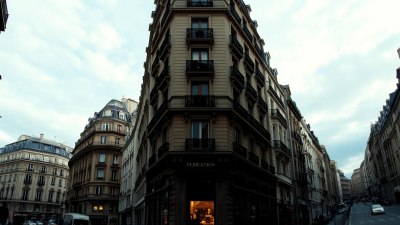Where Inception Twisted Streets in Paris
Explore the iconic twisting streets of Paris as featured in the movie Inception.

The movie 'Inception', directed by Christopher Nolan, is a masterclass in storytelling and visual artistry, taking audiences on a cerebral trip through the realms of dreams. One of the most memorable sequences in the film showcases the incredible architecture of Paris, with streets folding onto themselves in a breathtaking display of imagination. But where were these places filmed? Let's take a deeper dive into the fascinating locations that inspired these mind-bending visual effects.
The Parisian Influence
Paris stands as a city that is often portrayed in art and cinema, owing to its rich history, culture, and unique architecture. Nolan’s use of Parisian landscapes in 'Inception' serves as a tribute to the city’s affinity for romance, mystery, and dreams. The director's decision to utilize authentic locations rather than build sets adds depth to the dreamscape, allowing audiences to experience the surreal twists of reality seamlessly.
Saint-Germain-des-Prés
One of the standout areas featured in 'Inception' is the historic district of Saint-Germain-des-Prés. This vibrant neighborhood is known for its literary history, art galleries, and charming cafés. The twisted streets seen in the film reflect the labyrinthine nature of this area, embodying the enigmatic feel of dreams where logic is often upturned. In the film, Dom Cobb (played by Leonardo DiCaprio) traverses these streets that metaphorically represent his inner turmoil and subconscious battles.
Le Palais de Tokyo
Le Palais de Tokyo is another notable filming location that appears briefly in the film. It stands as a contemporary art museum and is known for its striking modern architecture juxtaposed against the elegance of classical Paris. In the context of 'Inception', this space serves as a significant backdrop that aligns with the film’s themes of art and illusion. The high ceilings and expansive galleries reflect the limitless possibilities of dreams.
Rue de la Huchette
This quaint street, located in the Latin Quarter, features heavily in one of the film's dream sequences. The narrow cobblestone paths and vibrant atmosphere of Rue de la Huchette evoke a sense of nostalgia and history, which plays into the film's exploration of memory and loss. Cobb’s interactions along this street serve as vital moments that illustrate his character’s struggle and longing.
Notre-Dame Cathedral
The Notre-Dame Cathedral, an iconic landmark, finds its way into various cinematic representations of Paris. In 'Inception', the cathedral is part of the dream architecture that Cobb navigates. The film’s portrayal of the cathedral, combined with the surreal environment, highlights the juxtaposition of reality and dreams, feeling both familiar and disorienting at once. Its imposing façade contrasts with the dreamlike sequences, emphasizing the intertwining of past regrets and present challenges that Cobb faces throughout his journey.
Montmartre
Montmartre, known for its bohemian vibe and picturesque streets, plays a key role in the dream cityscape. The neighborhood's eclectic mix of artists, cafés, and winding alleys creates an atmosphere ripe for exploration. Here, we see Cobb and his team bending the very fabric of their surroundings, representing the inner workings of their subconscious minds. The beauty of Montmartre, with its sweeping views of Paris, adds a layer of poignancy to Cobb's pursuit of resolution and redemption.
Architectural Contributions
The iconic structures of Paris are pivotal to the visual story of 'Inception'. With buildings and monuments re-contextualized and manipulated to create dream layers, Nolan worked closely with his team to create a sense of unease that perfectly captures the film's themes. From the twisting streets to the merging architecture, the film represents Paris as a city where the boundaries between dreams and reality dissolve.
Champs-Élysées and The Arc de Triomphe
The grand avenue of the Champs-Élysées and the majestic Arc de Triomphe are featured as part of the visual tapestry woven throughout the film. The wide boulevards and iconic landmarks provide a stunning backdrop against which the dynamic sequences unfold. The use of such recognizable structure helps to anchor the audience in a familiar location while also distorting it in unexpected ways.
The Importance of Dream Logic
Nolan’s decision to use real locations invites audiences to question their understanding of dreams and their fluidity. The streets of Paris, twisting like thought processes, are a metaphor for the complexities of human consciousness. As Cobb navigates these dream landscapes, the architecture of Paris mirrors his psychological journey. This alignment not only enhances the visual appeal but also deepens the narrative’s emotional impact.
Impact on Cinema
'Inception' has significantly influenced how filmmakers depict dreams, especially through the lens of urban environments. The twisted streets of Paris serve as inspiration for future projects that wish to explore themes of consciousness, memory, and the surreal. This film has left a lasting legacy on the portrayal of dreams in cinema, where viewers are continually challenged to analyze and understand the intricacies of the human psyche.
Conclusion
In conclusion, 'Inception' provides a stunning exploration of the relationship between dreams and reality, with the twisting streets of Paris serving as the perfect backdrop for its narrative. The film artfully captures the essence of a city known for its artistic history, making it a character in its own right. Each location featured in the film contributes to the overall surreal experience, drawing viewers into a world that blurs the lines between what is real and what is imagined.
When viewers think of 'Inception', they will undoubtedly remember the visual imagery of Paris, a city where dreams twist and turn just like the minds of its inhabitants. These scenes have cemented Paris’s status not just as a geographical location but as a landscape rich with possibility, artistry, and the complexities of human emotion.











